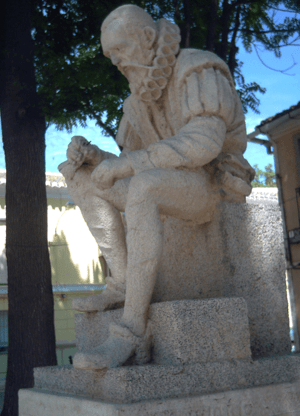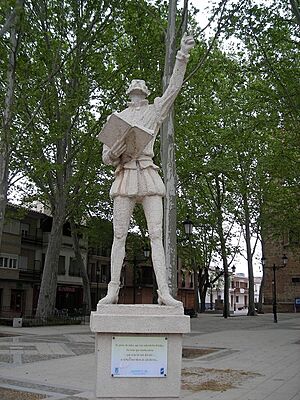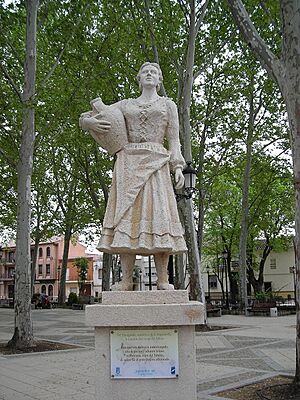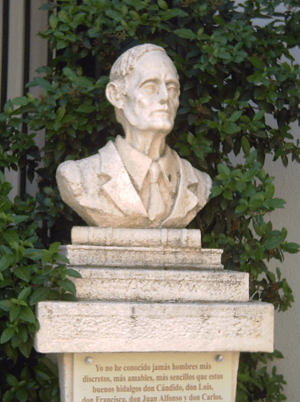Cayetano Hilario Abellán facts for kids
Cayetano Hilario Abellán (born May 21, 1916, in Argamasilla de Alba, Spain – died 1997) was a Spanish artist. He taught himself how to sculpt and created many artworks based on different ideas. He is best known for his sculptures of characters from the famous book Don Quixote by Miguel de Cervantes.
Contents
About Cayetano Hilario
Cayetano was born in a small town called Argamasilla de Alba. His father was the mayor there. From a young age, Cayetano loved sculpture. He first worked as a bricklayer, but he spent his free time learning to sculpt. After the Spanish Civil War ended, he became a full-time sculptor.
His sculptures often showed characters from Don Quixote. This book is said to have been partly written in Argamasilla de Alba. Cayetano even helped fix up the old jail, called the cave of Medrano. It's believed that Cervantes started writing Don Quixote while he was a prisoner there.
Cayetano was a peaceful person who respected everyone's ideas. He once said, "I am friends with everyone, and everyone is my friend. I have friends from all different groups. I see politics as a battle of ideas, not a path to violence." He married Cristina Torres and they had four children.
Because of his amazing art, the town council honored him in 1979. They named him a "favorite son" of the town. Cayetano passed away in 1997. In 2016, two special plaques were put up in Argamasilla de Alba to remember where he lived and worked.
Cayetano's Artworks
Many of Cayetano's sculptures are in public places in the La Mancha region of Spain. Other pieces are owned by private collectors. Cayetano admired famous sculptors like Auguste Rodin and Michelangelo. He also loved reading Cervantes' books.
He brought his artistic ideas to life by making "realistic" sculptures of the main characters from Don Quixote. He made them life-sized! To do this, he used people he knew, like his family and friends, as models.
Don Quixote Sculptures
This group of sculptures is inspired by the book Don Quijote de La Mancha. It includes four main artworks:
- Don Quixote
- His helper, Sancho Panza
- His dream lady, Dulcinea del Toboso
- The writer himself, Miguel de Cervantes
These sculptures are placed in the main squares of Cayetano's hometown.
Don Quixote
The impressive Don Quixote sculpture shows the knight when he was still Alonso Quijano. He looks like a normal person from the village. Later, he becomes the knight who wants to fight for justice. The sculpture shows Alonso Quijano reading one of his many knightly books. He is leaning on one hand and looking up, imagining his next adventures.
Sancho Panza
The sculpture of Sancho Panza also looks like a local person from the village. Sancho is carrying some wine and cheese. These are popular foods from that area.
Dulcinea of La Mancha
The sculpture of Aldonza Lorenzo is called Dulcinea of La Mancha by Don Quixote. Cayetano made this sculpture look like a real young country woman. She is carrying a pitcher full of water. She looks confident about the future.
Cervantes
Cayetano completed this group with his sculpture of the writer Miguel de Cervantes. This great artwork shows the Spanish writer from the 16th century. He is sitting and looks thoughtful. One of his hands holds some rolled paper. You can also see his left hand, which was injured. This injury gave Cervantes the nickname The one-handed man from Lepanto.
Other Sculptures
Cayetano also created other sculptures. Some honor well-known Spanish writers like Azorín and the poets Miguel Hernández and Vicente Cano.
He also made pieces that show typical country jobs. These include The Shepherd, The Harvester, and The Grape Harvest. He also sculpted The National Teacher and Musicians.
See also
 In Spanish: Cayetano Hilario Abellan para niños
In Spanish: Cayetano Hilario Abellan para niños






